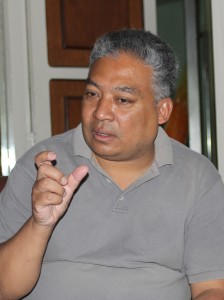Kathmandu Valley Preservation Trust (KVPT) ‘is a name that won’t ring a bell to most of us and yet its contribution to our culture is beyond appraisal. The KVPT team and it’s outsourcing has lended its contribution to rescue more than three-dozen significant monuments that otherwise wouldn’t have out lived the generations to come. The cultural heritage of Nepal reflects the rich culture, art and tradition upheld by Nepali people. They represent our identity and uniqueness. But with multiplying development pressures, people’s negligence and natural disasters over the years, our heritage has been prone to depletion. This battle between urbanization and cultural heritage can be a concrete example reflecting the ongoing debate between progress and preservation. In 2003, the Kathmandu Valley World Heritage Sites were included on the endangered list by UNESCO. Thousands of sacred structures, temples, stupas, shrines, fountains, water spouts, wells and monasteries would have been on the verge of extinction if it hadn’t been for KVPT’s restoration campaigns.
Located in Patan Durbar Square, KVPT is the only International organization exclusively dedicated to architectural preservation in Kathmandu Valley and it works in cooperation with Nepal’s Department of Archaeology. Eduard Sekler, a Harvard professor emeritus of architecture along with American architect Erich Theophile founded KVPT in 1991. ”The towns of the Kathmandu Valley with their intriguing parallels to the medieval cities of Europe are both an ideal field of study for the urban historian and a dramatic field of battle for the urban planner, designer and conservator.’ Remarked Professor Sekler in one of his articles published in Momentum. The first project of KVPT took place in 1991 and began with the Uma Maheswor temple in Kwalkhu, followed by the restoration of the Mani Gufa in Patan Durbar Square. The latter was relatively small but was in urgent need of repair.
Various organizations from Germany and the United States have been regularly donating for the noble cause of KVPT. Minor repair and restoration projects, which are part of the ongoing Patan Palace project, illustrate how significant projects can be undertaken for relatively modest amounts of money. Sponsoring such ‘architectural jewels’ not only saves an important monument, but also will be commemorated by a stone inscription to be designed and installed on-site by KVPT. KVPT’s Patan Royal Palace Project received donations of around $ 90,000 from the U.S. Ambassadors’ Fund for Cultural Preservation, The Federal Republic of Germany, Robert W. Wilson Challenge to Conserve our heritage Under the auspices of World Monuments Fund(USA), Ludwig Kuttner amp; Beatrix OST, The Princes Charities, Nepal Investment Bank Ltd (Mr. amp; Mrs. Prithivi B. Pandey), Sumitomo Foundation(Japan) and UNESCO World Heritage Centre, among others.
The trust head quarter gives training to interested enthusiasts and it frequently helps students who drop by for information and references in the trust’s library. The trust has also established the Nepal Architecture Archive at Harvard University’s Frances Loeb Library, to further facilitate the study of Kathmandu Valley’s architecture. Students, junior professionals and scholars from Nepal, Europe and the U.S. frequently join the Trust’s team to participate in restoration measures, documentation and research. Intercultural exchange of knowhow in a vivid, colorful culture enriches Eastern and Western professionals.Likewise, one can see the pride in the faces of the people who work here. After all it’s not just a salary that they earn here; their service preserves a dominant aspect of what Kathmandu Valley stands for. Sukra Sagar Shrestha, a retired employee of the Nepal Archeology Department, has been regularly lending his expertise and experience to the restoration projects. And his contribution, which he naively does not prefer to be talked about, is indeed praise worthy and requires recognition.
Numerous Experts as well as the UNESCO Mission to Nepal have been praising these efforts of restoration ‘Since everyone’s seeking employment abroad, we lack manpower at times.’ explained Suresh Shrestha, proud to be on board with the team. Currently, renovation of the Patan Palace Complex is in progress and KVPT is lending its technical support for reconstruction of the Bhaidegal Mandir. This trust very well deserves to be named as the guardian angel that looks after this city of temples, which in turn looks after its devotees.
[minigallery link=”file”] casino games

